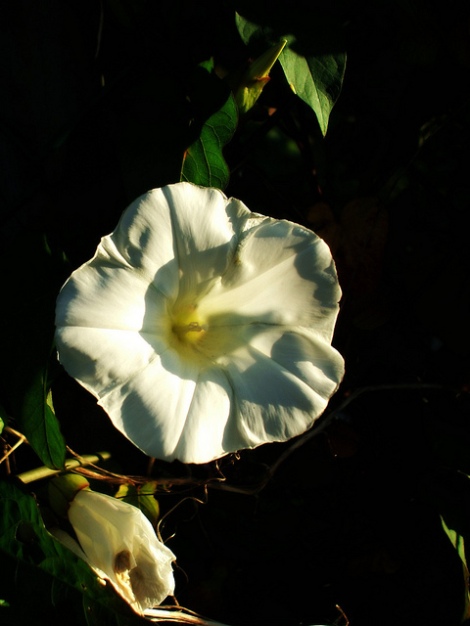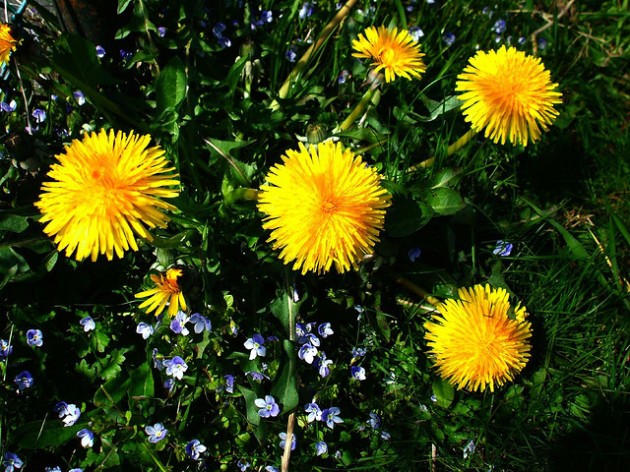Datura stramonium, known by the common names Jimson weed, Devil’s snare or datura, is a plant in the Solanaceae (nightshade) family. It is believed to have originated in the Americas, but is now found around the world. Other common names for D. stramonium include thornapple and moon flower, and it has the Spanish name Toloache.
For centuries, datura has been used as a herbal medicine to relieve asthma symptoms and as an analgesic during surgery or bonesetting. It is also a powerful hallucinogen and deliriant, which is used spiritually for the intense visions it produces. However, the tropane alkaloids which are responsible for both the medicinal and hallucinogenic properties are fatally toxic in only slightly higher amounts than the medicinal dosage, and careless use often results in hospitalizations and deaths.
Scientific classification
Kingdom: Plantae
(unranked): Angiosperms
(unranked): Eudicots
(unranked): Asterids
Order: Solanales
Family: Solanaceae
Genus: Datura
Species: D. stramonium
Description
D. stramonium is a foul-smelling, erect annual, freely branching herb that forms a bush up to 2 to 5 feet (60–150 cm) tall.[4][5][6]
The root is long, thick, fibrous and white. The stem is stout, erect, leafy, smooth, and pale yellow-green. The stem forks off repeatedly into branches, and at each fork forms a leaf and a single, erect flower.[6]
The leaves are approximately 3 to 8 inches (8–20 cm) long, smooth, toothed,[5] soft, irregularly undulate.[6] The upper surface of the leaves is a darker green, and the bottom is a light green.[5] The leaves have a bitter and nauseating taste, which is imparted to extracts of the herb, and remains even after the leaves have been dried.[7]
Datura stramonium generally flowers throughout the summer. The fragrant flowers are trumpet-shaped, white to creamy or violet, and 2 1⁄2 to 3 1⁄2 inches (6–9 cm) long, and grow on short stems from either the axils of the leaves or the places where the branches fork. The calyx is long and tubular, swollen at the bottom, and sharply angled, surmounted by five sharp teeth. The corolla, which is folded and only partially open, is white, funnel-shaped, and has prominent ribs. The flowers open at night, emitting a pleasant fragrance and is fed upon by nocturnal moths.[6]
The egg-shaped seed capsule is 1 to 3 inches (3–8 cm) in diameter and either covered with spines or bald. At maturity it splits into four chambers, each with dozens of small black seeds.[6]
Range and habitat
Datura stramonium is native to North America, but was spread to the Old World early. It was scientifically described and named by Swedish botanist Carl Linnaeus in 1753, although it had been described a century earlier by herbalists, such as Nicholas Culpeper. Today, it grows wild in all the world’s warm and moderate regions, where it is found along roadsides and at dung-rich livestock enclosures. In Europe, it is found as a weed on wastelands and in garbage dumps.
The seed is thought to be carried by birds and spread in their droppings. Its seeds can lie dormant underground for years and germinate when the soil is disturbed. People who discover it growing in their gardens, and are worried about its toxicity, have been advised to dig it up or have it otherwise removed.
Toxicity
All parts of Datura plants contain dangerous levels of the tropane alkaloids atropine, hyoscyamine and scopolamine which are classified as deliriants, or anticholinergics. There is a high risk of fatal overdose amongst uninformed users, and many hospitalizations occur amongst recreational users who ingest the plant for its psychoactive effects.
The amount of toxins varies widely from plant to plant. There can be as much as a 5:1 variation between plants, and a given plant’s toxicity depends on its age, where it is growing, and the local weather conditions. Additionally, within a given datura plant, toxin concentration varies by part and even from leaf to leaf. When the plant is younger, the ratio of scopolamine to atropine is approximately 3:1; after flowering, this ratio is reversed, with the amount of scopolamine continuing to decrease as the plant gets older. This variation makes Datura exceptionally hazardous as a drug. In traditional cultures, a great deal of experience with and detailed knowledge of Datura was critical in order to minimize harm. An individual datura seed contains about 0.1 mg of atropine, and the approximate fatal dose for adult humans is >10 mg atropine or >2–4 mg scopolamine.
Datura intoxication typically produces delirium (as contrasted to hallucination); hyperthermia; tachycardia; bizarre behavior; and severe mydriasis with resultant painful photophobia that can last several days. Pronounced amnesia is another commonly reported effect.The onset of symptoms generally occurs approximately 30 minutes to an hour after smoking the herb. These symptoms generally last from 24 to 48 hours, but have been reported in some cases to last as long as 2 weeks.
As with other cases of anticholinergic poisoning, intravenous physostigmine can be administered in severe cases as an antidote.
Medicinal uses
Datura has long been used as an extremely effective treatment for asthma symptoms. The active anti-asthmatic agent is atropine, which causes paralysis of the pulmonary branches of the lungs, eliminating the spasms that cause the asthma attacks. The leaves are generally smoked either in a cigarette or a pipe. This practice of smoking datura to relieve asthma has its origins in traditional Ayurvedic medicine in India. After this was discovered during the late 18th century by James Anderson, the English Physician-General of the East India Company, the practice quickly became popular in Europe.
The Zuni used to use datura as an analgesic, to render patients unconscious while broken bones were set. The Chinese also used it in this manner, as a form of anaesthesia during surgery.
Atropine and scopolamine (both of which are found in very high concentrations in datura) are muscarinic antagonists which can be used to treat Parkinson’s disease and motion sickness, and to inhibit parasympathetic stimulation of the urinary tract, respiratory tract, GI tract, heart and eye.
Datura can be used to assist in the process of breaking drug addictions, by reducing the symptoms of delirium tremens and morphine withdrawals.
Other medicinal uses for datura include providing relief from sore throat or toothache and getting rid of parasites.
Datura should be avoided by patients with heart problems, glaucoma, enlarged prostate, urinary difficulties, fluid buildup in the lungs, or bowel obstructions.
Spiritual uses
The ancient inhabitants of what is today central and southern California used to ingest the small black seeds of datura to “commune with deities through visions”. Across the Americas, other indigenous peoples such as the Algonquin, Cherokee, Marie Galente and Luiseño also utilized this plant in sacred ceremonies for its hallucinogenic properties. In Ethiopia, some students and debtrawoch (lay priests), use D. stramonium to “open the mind” to be more receptive to learning, and creative and imaginative thinking.
The common name “datura” has its roots in ancient India, where the plant is considered particularly sacred—believed to be a favorite of the Hindu god Shiva Nataraja.
Cultivation
Datura prefers rich, calcareous soil. Adding nitrogen fertilizer to the soil will increase the concentration of alkaloids present in the plant. Datura can be grown from seed, which is sown with several feet between each plant. Datura is sensitive to frost, and so should be sheltered during cold weather. The plant is harvested when the fruits are ripe, but still green. To harvest, the entire plant is cut down, the leaves are stripped from the plant, and everything is left to dry. When the fruits begin to burst open, the seeds are harvested. A single intensively planted acre can produce 1,000 to 1,500 pounds (1,100–1,700 kg/ha) of leaf and 700 pounds (780 kg/ha) of seed.[29]
Etymology
The genus name is derived from dhatura, an ancient Hindu word for a plant. Stramonium is originally from Greek, strychnos στρύχνος “nightshade” and maniakos μανιακός “mad”.
In the United States the plant is called jimson weed, or more rarely Jamestown weed; it got this name from the town of Jamestown, Virginia, where British soldiers consumed it while attempting to suppress Bacon’s Rebellion. They spent eleven days in altered mental states:
The James-Town Weed (which resembles the Thorny Apple of Peru, and I take to be the plant so call’d) is supposed to be one of the greatest coolers in the world. This being an early plant, was gather’d very young for a boil’d salad, by some of the soldiers sent thither to quell the rebellion of Bacon (1676); and some of them ate plentifully of it, the effect of which was a very pleasant comedy, for they turned natural fools upon it for several days: one would blow up a feather in the air; another would dart straws at it with much fury; and another, stark naked, was sitting up in a corner like a monkey, grinning and making mows [grimaces] at them; a fourth would fondly kiss and paw his companions, and sneer in their faces with a countenance more antic than any in a Dutch droll.
In this frantic condition they were confined, lest they should, in their folly, destroy themselves — though it was observed that all their actions were full of innocence and good nature. Indeed, they were not very cleanly; for they would have wallowed in their own excrements, if they had not been prevented. A thousand such simple tricks they played, and after eleven days returned themselves again, not remembering anything that had passed.
– The History and Present State of Virginia, 1705[31]









![20170123050651-f09370cbed.[gif-2-mp4.com] 20170123050651-f09370cbed.[gif-2-mp4.com]](https://live.staticflickr.com/428/32472212275_9af8805d25_m.jpg)


